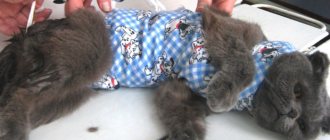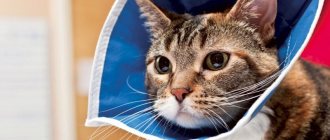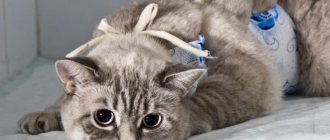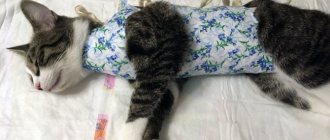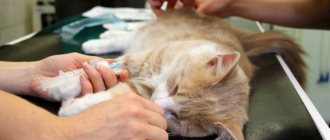Sterilization of cats is a surgical procedure that involves the removal of reproductive organs, which leads to loss of reproductive function and the cessation of external manifestations of sexual desire. Such a radical procedure is often resorted to by owners of domestic cats who do not want to bother with their offspring.
Sterilization is carried out by experienced doctors in a veterinary clinic. After such a procedure, the animal must be properly cared for, which will eliminate possible postoperative complications.
In the article we will talk about the features of caring for a cat after sterilization, how to treat sutures, when to remove the blanket, how to feed it properly, when you can drink water, after how many days the animal can be washed, why a cat should not jump, and what else is unacceptable to do after surgery.
Classification of postoperative sutures
How quickly the sutures heal after surgery largely depends on the nature of their application and the materials used. In this regard, post-surgical procedures are usually classified as follows.
- Bloodless (the edges of the wound are glued together with a special plaster) and bloody (a classic suture that is applied manually with a medical instrument). In turn, the latter are divided into:
- simple knots (applied at a distance of 1–2 cm from each other, after which the knot is tightened until the edges of the incision touch);
- intradermal continuous (considered the most effective, since after their healing there are no traces left);
- mattress (applied after abdominal surgery);
- purse string (used in plastic surgery, as well as in operations to reduce the volume of the stomach);
- entwining (circular sutures that are used to sew together blood vessels and hollow organs).
- Manual (applied with a needle, thread and other special tools) and mechanical (performed with a medical stapler).
- Submersible (applied during operations on internal organs with threads that are absorbable or implanted into living tissue) and removable (they are used to stitch the skin, and after the edges of the wound have fused, the threads are removed).
Absorbable sutures are made in cases where long-term fixation of the edges of the incision is required, for example, when cutting the uterus during a cesarean section. As a rule, they are performed with threads from purified connective tissue, which is subsequently rejected into the organ cavity. To apply removable sutures, threads and other fasteners made of cotton, silk, metal and other non-absorbable materials are used (more than 30 varieties in total).
Hand stitching tools
How to care for the suture after surgery?
Once the edges of the incision tighten, there will be no need for additional support. Removal of sutures in the head, face and neck area occurs already on the 5th day after the operation. If they were applied in the area of the torso or limbs, then it will take at least 10 days for the wound to heal. Daily dressings are necessary for the first few days. The patient usually spends this time in the hospital. After discharge, tight bandages are usually no longer needed. But if necessary, you can always change the dressing at the nearest hospital or medical center.
Caring for the suture after surgery consists of daily treating the incision area with an antiseptic and taking medications that accelerate tissue regeneration. All medications for home therapy are used strictly according to the doctor’s recommendation!
Treatment of sutures is usually carried out with ready-made pharmaceutical preparations or homemade antiseptics, such as solutions of iodine, potassium permanganate, brilliant green or hydrogen peroxide. To avoid getting a chemical burn when performing such procedures, the liquid for disinfection should be prepared only according to a prescription issued by a doctor.
To speed up regeneration processes, external agents with wound healing and antibacterial effects are used. These include balsamic liniment (better known as Vishnevsky ointment), levomekol, ichthyol ointment and many others.
Pain of varying intensity after surgery is absolutely normal. If discomfort is severe, analgesics approved by your physician may be used.
Additional recommendations for suture care after surgery
In addition to medical procedures, certain lifestyle adjustments are also necessary in the postoperative period. In particular, the following rules must be adhered to:
- Limit physical activity. Any high and medium intensity exercise (running, aerobics, etc.) during this period is strictly contraindicated.
- Avoid heavy lifting. As a rule, a person who has undergone surgery should not lift more than 2–2.5 kg. This rule is especially relevant when caring for a suture on the abdomen after surgery.
- Limit mobility in the waist area (avoid sharp and high-amplitude bends and turns of the body) after abdominal surgery.
- Carry out water procedures with great care. Before the stitches are removed, or better yet, before a scar forms, it is strongly recommended not to wet the wound.
- Avoid any pressure on the wound. When it comes to how to care for a suture after surgery, this is one of the main rules.
- In cases where surgery was performed on an arm or leg, the injured limb should be placed above the level of the heart (for example, placed on a pillow) during sleep. If the wound is above the level of the neck, then it is better to sleep with the head of the bed raised by 45° (two pillows are enough for this).
- During abdominal operations, observe bed rest until the doctor allows you to break it. To avoid bedsores and improve blood circulation, you can perform simple movements such as lifting your limbs and performing light self-massage.
- Strictly follow the diet prescribed by your doctor (especially after abdominal surgery).
- Protect the wound from exposure to direct sunlight. After the tissue has healed and until a full-fledged skin forms in this area, you can use sunscreen.
Cat's diet after sterilization
After sterilizing a cat, special attention should be paid to its diet and significant adjustments should be made to the daily menu. Since after this procedure the metabolic process in the animal’s body slows down and other important changes occur in the functioning of internal organs, proper nutrition will become an integral part of proper care for your pet.
Rules for feeding a cat after sterilization:
1. In the first days after surgery, the cat should not be given solid food. The stool must be liquid so that the postoperative sutures do not come apart during a visit to the toilet.
2. For the first 2-4 days, the pet’s diet is reduced and is only a third of the usual dose.
3. On days 4-5 after surgery, you can gradually increase the portions by 100-150 g per day.
4. Since cats are prone to obesity after sterilization, the usual daily food intake should be reduced by 120-130 g.
What and when to feed
On the first day after sterilization, the cat should not be fed until it recovers from anesthesia. If by the evening of the first day after waking up the animal demonstrates severe hunger, you can give it a little low-fat broth from a syringe.
Food for a cat after sterilization should be easily digestible and of high quality. Fatty meats, raw and river fish, fatty dairy products, smoked meats, pickles, legumes, raw eggs, as well as pearl barley, oatmeal and semolina are excluded from the diet.
To prevent urolithiasis and obesity, experts recommend feeding your cat 2-3 times a day in small portions.
Daily diet for an adult cat:
· 100-120 g of meat;
· 30-60 g of low-fat dairy products; · 30-50 g of vegetables; · 10-20 g of cereals. If symptoms of obesity appear after sterilization, the cat is transferred to fractional meals.
If the owner feeds a domestic cat with special food, it is recommended to choose high-quality premium or super-premium formulations. Cheap food contains a lot of salts and heavy minerals that contribute to the development of liver and kidney diseases. The range of industrial foods includes special formulations for sterilized cats. They can be used for everyday feeding of your pet, but you should not give such food to your cat in the first days after sterilization.
When can you give water?
You cannot feed and water the animal immediately after surgery. You need to wait until the cat recovers from anesthesia. Water can be given in small quantities, soldered through a syringe without a needle.
In what cases should you consult a doctor?
Seeking help from a doctor during the healing process of a suture is a completely normal practice, even in the absence of serious problems. And in the event of adverse reactions due to a violation of the treatment regimen or any unforeseen circumstances, it is absolutely impossible to delay it. First of all, it is dangerous to ignore the following symptoms:
- bleeding that cannot be stopped by conventional means;
- high temperature (more than 38 degrees);
- weakness, chills;
- increasing pain or other progressive discomfort that cannot be relieved with medications;
- purulent discharge of a bright yellow or green color with a thick consistency and very often with an unpleasant odor;
- severe redness, swelling, or swelling in the wound area;
- the skin at the site of injury is hard and hot to the touch;
- the appearance of a rash or blisters;
- Suspicion of seam dehiscence.
How to feed a neutered cat correctly: is a diet necessary?
The cat's testes release male sex hormones into the blood, which greatly affect metabolism.
After parting with this organ, the cat may develop a tendency toward obesity, and in the absence of such an important stimulus as the sexual instinct, the pet begins to be more interested in food than before. How to properly feed a neutered cat? The simplest solution is to trust manufacturers of ready-made diets that produce food for sterilized animals. The differences between such diets and conventional products are most often the following:
- reducing calories by reducing the amount of fat;
- reducing the amount of carbohydrates, which is observed less frequently;
- increasing the volume of dietary fiber;
- maintaining optimal urine pH to prevent urolithiasis.
Unfortunately, not all manufacturers take a responsible approach to the development of such food, often not taking into account the fact that a castrated cat remains a predator with strictly defined biological needs.
Some go overboard with the amount of carbohydrates, others replace almost all animal protein with vegetable protein, apparently counting on the low digestibility of these components in carnivores, which will prevent fat deposition.
Still others overload the diet with ballast substances and indigestible fiber in order to reduce the animal’s appetite. All this definitely does not benefit the health of cats, so to the question of how to properly feed a sterilized cat, there is only one answer: the diet should be of high quality, with a high meat content, but feeding standards must be reduced.
How long does it take for a wound to heal after surgery?
The rate of healing of a postoperative wound depends on many conditions. Among them:
- age;
- body mass;
- state of immunity;
- state of the cardiovascular system.
On average, it takes about 3 months from the moment of surgery to the formation of a scar. Depending on the complexity of the operation and if there are complications, this period may last 12 months. Tissue regeneration takes place in 4 stages.
- Inflammation (5–7 days). The body's standard defense reaction to damage. During this period, there is an increased production of substances that stimulate blood clotting.
- Polyferation (from 10 days to 1 month). At this stage, the formation of young connective (granulation) tissue, penetrated by a dense network of microvessels, occurs. At first it is bright red in color and grainy in consistency, but as the wound heals it becomes pale and smooth, and its bleeding decreases.
- Epithelization (from 1 to 3 months). The connective tissue is finally formed. Skin begins to form at the site of the wound. The number of vessels decreases, a scar forms.
- Scar formation (from 3 to 12 months). Temporary vessels completely disappear. Fibers of collagen and elastin - elements of connective tissue - form the scar.
Rehabilitation of cats at home
Sterilization is now a completely ordinary operation; many owners seek such a service at a veterinary clinic or call a doctor at home to avoid unwanted offspring.
The procedure does not take much time, and after a certain period the animal begins to live a normal life. But until complete recovery from surgery, it is important to provide proper care for the cat. Otherwise, there is a risk of postoperative complications arising from lack of attention to the cat and ignoring simple rules. In practice, several sterilization methods are used. The classic method is to perform an operation by cutting the peritoneal line of the abdomen. After internal manipulations, the incision is sutured. This is the most commonly used sterilization option. There is also the option of making an incision from the side; this method has a high risk of injury compared to others, since it is sometimes difficult to remove the uterus due to the small size of the hole made. They also perform laparoscopy on cats. This method is the safest. In addition, it is not practiced in all clinics.
Depending on which surgical method was chosen, your veterinarian will prescribe postoperative procedures. But there are also general rules regarding caring for a cat after sterilization. The operation is an invasive procedure, so the impact on the body is quite serious. In this regard, you should not leave your cat alone. It is necessary to monitor it and care for it properly.
Caring for a cat after anesthesia
Sterilization of cats is always carried out under anesthesia. During medical sleep, body temperature decreases, so after sterilization, provide the animal with additional warmth. If you plan to take her home right away, it is better to place additional fabric on the bottom of the carrier. It is also recommended to wrap the kitty in something warm, especially if the street conditions are not pleasant. Naturally, you should wrap your pet as carefully as possible.
At home, during the first 24 hours after surgery, the cat will recover from anesthesia. It always looks strange and sometimes scary, but don’t worry, this is a completely normal situation. The pet is poorly oriented in space, sometimes does not understand where to go and what to do. She may take a few awkward steps, then lie down, or she may simply walk backwards. You should not react violently to what is happening, much less laugh.
It is necessary to carefully pick up your pet and carry it to the bedding to ensure proper rest. Trying to walk or run will still lead to failure, so it is better if the cat is in a lying position. A cat's recovery from anesthesia usually takes up to 8 hours, but for some pets it takes longer.
Important!
After anesthesia, a cat always does not behave quite normally, but if the owner is very embarrassed by something or if the period of “coming out of anesthesia” has been prolonged, then call the veterinarian immediately.
Try to organize a safe space so that the cat does not harm itself after anesthesia. All wires and other objects that could become entangled should be removed from the floor surface. Also try to cover the furniture so that the cat does not try to jump into it. Too sudden movements can cause the seams to come apart. Try to provide a calm environment and keep other animals and children away from the sterilized pet. It would be optimal to isolate the pet so that no one bothers her at all.
Physiological needs after surgery
On the first day after surgery, the cat may sometimes experience vomiting and involuntary urination. These processes are also within normal limits, so do not scold your cat under any circumstances. You just need to remember that the described situation can happen and be careful when letting the animal onto sofas, beds, and expensive carpets. You can keep a bag ready for the animal to vomit in. You can tell that a cat is about to vomit by its continuous licking.
Know!
The cat may not eat for the first two days, but it must have access to water.
You can provide water to your cat 3 hours after surgery. But it is recommended to feed the cat only 5 - 7 hours after sterilization. It is recommended to reduce portions. The optimal size is about a third of the usual amount. If before the operation the cat ate mainly dry food, then it is recommended to abandon it during recovery. It is better to give preference to soft food. In the first three days, the cat may have a poor appetite, but if it continues to refuse food, then you should consult a veterinarian.
How to care for a wound when the stitches are removed after surgery?
It would be useful to remind you that stitches should only be removed by a specialist - a doctor or nurse. It is strictly forbidden to perform this procedure yourself, due to the high risk of causing infection in the wound or causing bleeding.
Treatment of the incision site after removal of the sutures is carried out using the same means as before. Treatment procedures last until the wound is completely healed. This usually takes about 1 week.
Memo to the cat owner for 7 days
Owners whose cats have undergone castration should follow simple rules for the next 7-10 days. Which will allow you to undergo rehabilitation without problems.
Limit your time outside
Even if the cat feels good after castration, runs around the apartment and plays actively, you should not let him outside. Climbing trees and running into other cats can cause infection. In addition, it is necessary to protect your pet from intense stress. Yes, a cat can be capricious and ask to go for a walk, but you can’t follow the lead. It is important to explain the rehabilitation rules to all household members so that actions are coordinated and the animal remains safe.
Don't wash your cat right away
For a week after castration, refrain from bathing the animal, even if the cat has wet itself. Until the tissues are completely healed, water can become a conduit for infection and cause an abscess. Be patient. As soon as the stitches are removed and the wound at the incision site has healed well (to say the least), you can wash the cat with peace of mind.
What consequences should you be wary of?
The problem of urolithiasis comes first. Normally, a cat leaves territorial marks, and urine does not stagnate in the bladder. Now the cat will defecate much less frequently, which means the salts have time to form crystals and form deposits in the cavities and ducts of the urinary system.
The first thing the owner must do is to remove from the pet’s diet foods that contribute to the formation of stones (fish, dairy products), and under no circumstances give spicy, salty or fatty foods.
The second is accessible drinking. Cats are not big drinkers, but a lack of access to water will greatly aggravate the situation. Clean the litter box often. Animals may refuse to relieve themselves again if the litter box is not cleaned. The cat begins to tolerate it, the urine stagnates, crystallization and inflammatory processes occur.
What to feed the cat, transition to a new diet?
After castration, a cat's metabolic rate will change. The purr will become calmer and the need for large amounts of calories will disappear. The diet should be reduced. Make it nutritious, as free as possible from ballast, which can turn into fat deposits.
Substances that help remove excess salts from the body are added to specialized feeds. The food is easier to digest and still provides enough energy for play.
Be sure to discuss feeding rules with your veterinarian so that they can help you calculate the daily intake based on the animal’s weight. Make your pet's nutrition complete but safe, based on the recommendations of experts or give preference to a trusted manufacturer.
It will be useful for you to know how to choose the right food for a neutered cat.
Professional care for postoperative sutures at Stoletnik MC
If in any matters related to taking care of your own health, you prefer to trust professionals, you are welcome at the medical office. To help those who are not sure how to properly care for a suture after surgery, a wide range of post-operative services is available. Among them:
- dressing large and small;
- removal of stitches up to 5 cm;
- removal of sutures 5–10 cm;
- removal of stitches more than 10 cm;
- sanitation of the wound surface;
- scar excision;
- and much more.
The responsibility and high professionalism of the clinic’s staff is the key to the safe and speedy recovery of our patients. And the affordability of the services provided will eliminate the need to waste time and nerves on trips to the clinic. Sign up for procedures by phone: +7 (8412) 999-395, 76-44-20. We are waiting for you at the address: Penza, st. Chaadaeva, 95 (Shuist microdistrict).
Literature
- Belyaev A.N., Kozlov S.A., Taratykov I.B., Novikov E.I. Patient care in a surgical clinic: textbook. allowance. – Saransk: Mordovian University Publishing House, 2003. – 136 p.
- Buyanov V. M. Egiev V. N. Udotov O. A. Surgical suture. – M.: Antis, 2000. – 92 p.
- Zoltan J. Operating technique and conditions for optimal wound healing. – Budapest: Publishing House of the Academy of Sciences of Hungary, 1983. – 175 p.
- Mironova E. N. Fundamentals of physical rehabilitation. – M.: MOO “Academy of Safety and Survival”, 2021 – 310 p.
- Semenov G.M., Petrishin V.L., Kovshova M.V. Surgical suture - St. Petersburg: Peter, 2001. - 256 p.
Author: Korolev E. S.
Reviewer: reflexologist Kurus A. N.

